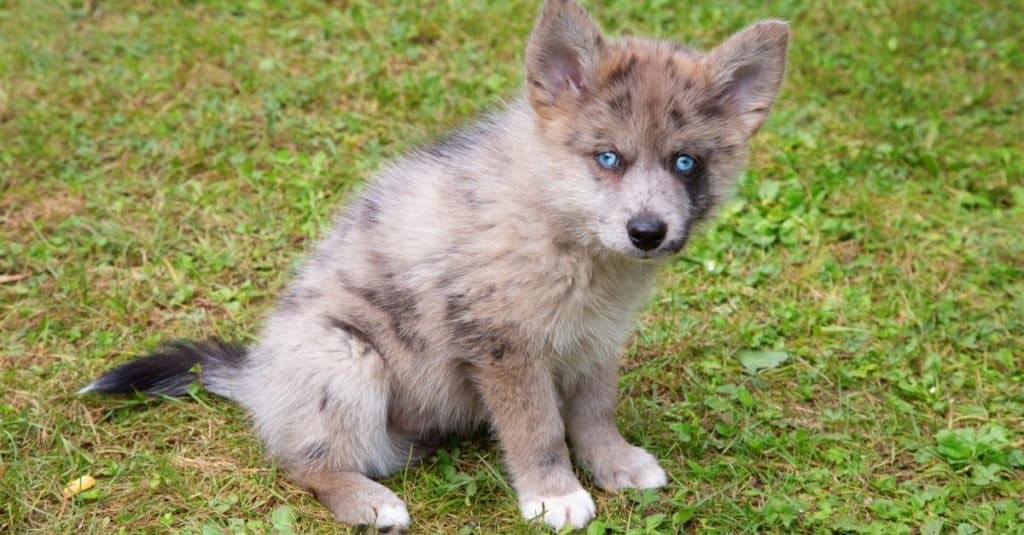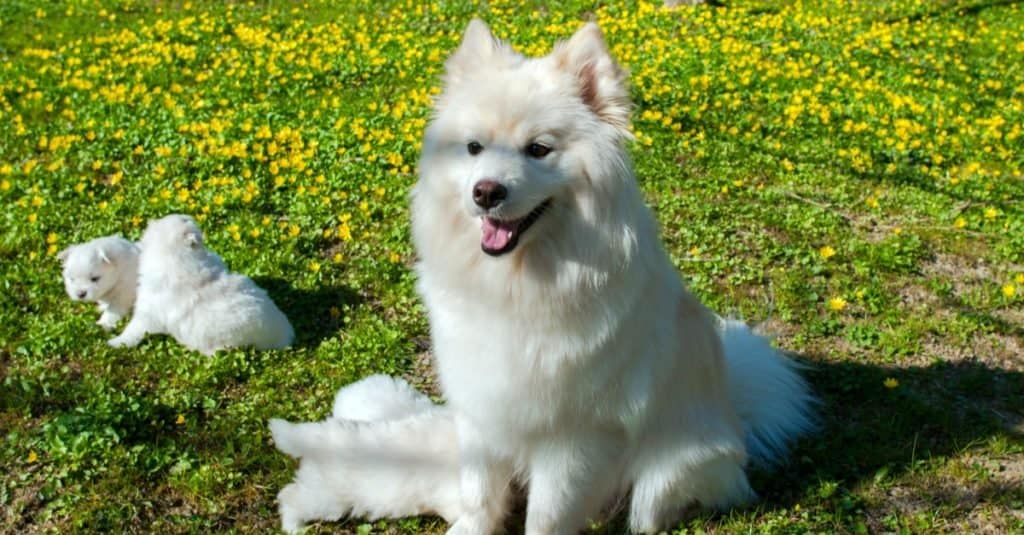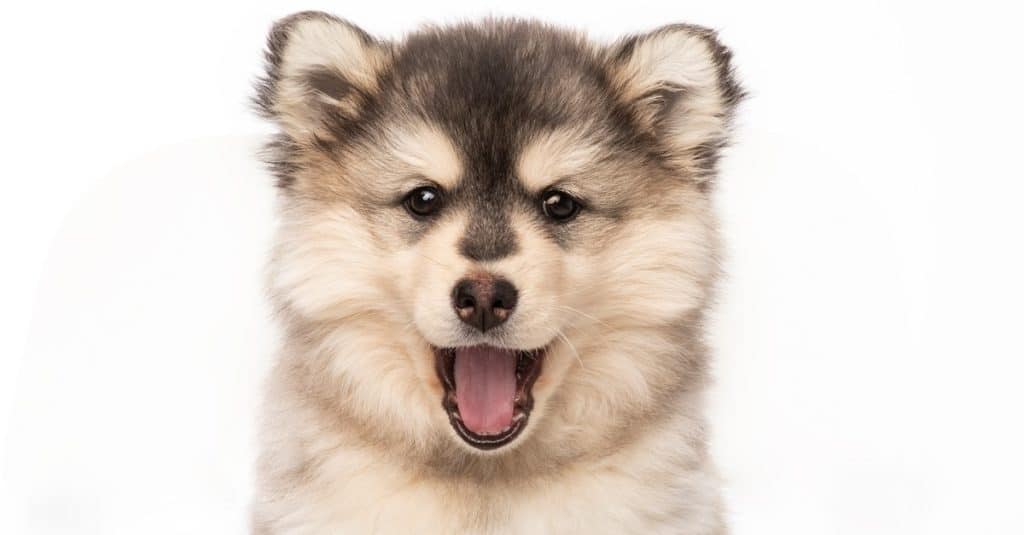Pomskies were created in the United States of America in 2012 and are now widespread in the United States and Europe as a designer dog breed.
Pomskies are cute, designer dogs that have become trendy companions, which is just one Pomsky fact that people adore. Pomskies are also known as ‘Huskeranians’ and are active little dogs. Today, Pomskies are widespread across North America and Europe. Here are ten more incredible Pomsky facts that you might like to know, especially if you plan on becoming a guardian of this dog.
1. A Pomsky Is a Siberian Husky and Pomeranian Mix

Max Maximov/Shutterstock.com
Pomskies are a combination of Siberian Huskies and Pomeranians. Because of this fusion, Pomskies look very similar to Siberian Huskies but are just a lot smaller. But there are cases where the Pomsky seems more like a Pomeranian.
2. Pomsky Appearances Vary Considerably
Because Pomskies are a designer breed and a mix of two different species, their size, color, and appearance differ quite substantively. Siberian Huskies generally grow to 23.5 inches tall and weigh about 60 pounds. Pomeranians are smaller dogs and grow typically to seven inches tall and weigh seven pounds.
Because of these variations, Pomskies can range in size and weight anywhere between the heights and weights of Siberian Huskies and Pomeranians. Still, they are usually 15 inches tall and weigh around 30 pounds. Pomsky coats also vary, as the coat patterns of Siberian Huskies do. Additionally, would-be Pomsky owners need to remember that Pomskies have a double coat and shed a lot.
3. Pomskies Need Extensive Grooming

Fedor Selivanov/Shutterstock.com
The Siberian Husky and Pomeranian have double coats, and the Nordic breed of Siberian Husky has incredibly dense fur. This thick coat is valuable as they help these dogs weather the harsh winters of Siberia, where they pull sleds. It’s a fact that the Pomsky’s coat is similar, so its owners have a full-time job ahead in grooming it to maintain its comfort and health. Owners must brush their Pomskies daily and include additional grooming like teeth brushing, nail clipping, and bathing. Breeders also recommend that owners start these grooming processes at a young age so that the Pomsky becomes accustomed to them.
4. Pomsky Temperaments Vary
Two Pomskies are often quite different in character, and this is due to their parents’ genetic contribution. Friendlier, more energetic parents frequently result in more social and active Pomskies, which comes from alternative pairings.
5. Pomskies Are Vocal
Aspirant Pomsky owners must remember that this dog is incredibly vocal and have howling tendencies. This vocal tendency is attributable to its parents. Siberian Huskies are vocal and typically love expressing themselves through a combination of howls and barks. Add Pomeranians to the mix, which are also quite vocal and frequently bark when happy, scared, anxious, playing, or bored, and you have a musical breed.
But having a vocal dog might be an issue for people living in apartments. To mitigate this issue, you must train the Pomsky not to bark unnecessarily. Nip this behavior in the bud with professional training, and you will help to avoid annoying the neighbors. However, it is pretty challenging to train Pomskies because they are a stubborn breed, so prepare for an uphill battle if you want the most from these pets.
6. You Must Train Your Pomsky

Pomskies are intelligent little dogs with strong personalities, often resulting in them being stubborn and tough to train. This stubborn trait likely comes from their Pomeranian heritage. But no matter the origins of this characteristic, if you don’t have experience rearing these dogs, you might become easily frustrated with their strong personalities.
However, be patient during training, keep them calm, and assert leadership to signify your dominance. It’s a fact that dog breeds recognize dominance, and it is also easier to start training dogs when they’re puppies. The same principles apply to training Pomskies. They’re more amenable to training when younger and respond well to a reward-based method.
7. Pomskies Are Suitable for Homes and Apartments
Pomskies are small dogs that grow to 15 inches tall and weigh approximately 30 pounds. These dimensions make them the perfect house dog. Despite their size, they need plenty of attention and exercise, which is why they are not suitable for living outdoors and do not live outdoors naturally. However, Pomskies are intelligent and quickly adapt to their environment, making them ideal for life in a home or apartment.
Pomskies are also social dogs, so they happily get along with others if you familiarize them with people and other pets while they are still young. And although Pomskies are suitable for living in homes and apartments, they are energetic dogs and quickly get bored. Owners must exercise them regularly and provide them with toys to engage their curious personalities.
8. Pomskies Can Be Bred In Different Ways

Crystal T/Shutterstock.com
Breeders produce Pomskies through natural mating processes or artificial insemination. The parent breeds are Siberian Huskies and Pomeranians. The male Pomeranian will breed with the female Siberian Husky, but the vast difference in size often makes this difficult. Because of this obstacle, many breeders create Pomskies using artificial insemination. They will achieve this by inserting the male Pomeranian’s semen into the female Siberian Husky just before the dog starts her ovulation cycle. The insemination must occur immediately after harvesting the sperm unless it has been frozen correctly for future application.
9. Pomskies Have a Life Expectancy of 13 to 15 Years
Fifteen years is the maximum estimated lifespan of this breed. Because the Pomsky breed is new, scientists don’t yet have enough statistics to determine the lifespan of the Pomsky. Instead, they rely on facts about the lifespan of the separate breeds to estimate how long the Pomsky will live. So, this number range is an informed estimation rather than a fact.
10. Pomskies Often Have Health Issues
One well-known Pomsky fact is that the parent breeds are susceptible to various health issues and concerns. Because of this genetic heritage, Pomskies are likely to experience similar health problems, which is a marker in most designer breeds.
Siberian Huskies and Pomeranians are prone to health issues like hip dysplasia, skin irritations and issues, progressive retinal atrophy, allergies, patellar luxation, epilepsy, heart disease, collapsing trachea, and eye concerns. Pomskies have the potential to inherit all of these issues. When producing a purebred dog, breeders can try to reduce the development of some of these health issues by being selective in their choice of healthy breeding dogs.
Next Up:
- PomskyPomsky vs Husky: What’s the Difference?
- Pomsky vs Klee Kai: 5 Key Differences
- Alaskan Husky vs Siberian Husky: What’s the Difference?
- Why Do Siberian Huskies Have Blue Eyes?
The post 10 Incredible Pomsky Facts appeared first on AZ Animals.
from Animal News, Facts, Rankings, and More! - AZ Animals https://ift.tt/XrFA1xm